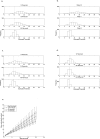Psychophysical measurements in children: challenges, pitfalls, and considerations
- PMID: 28507816
- PMCID: PMC5429739
- DOI: 10.7717/peerj.3231
Psychophysical measurements in children: challenges, pitfalls, and considerations
Abstract
Measuring sensory sensitivity is important in studying development and developmental disorders. However, with children, there is a need to balance reliable but lengthy sensory tasks with the child's ability to maintain motivation and vigilance. We used simulations to explore the problems associated with shortening adaptive psychophysical procedures, and suggest how these problems might be addressed. We quantify how adaptive procedures with too few reversals can over-estimate thresholds, introduce substantial measurement error, and make estimates of individual thresholds less reliable. The associated measurement error also obscures group differences. Adaptive procedures with children should therefore use as many reversals as possible, to reduce the effects of both Type 1 and Type 2 errors. Differences in response consistency, resulting from lapses in attention, further increase the over-estimation of threshold. Comparisons between data from individuals who may differ in lapse rate are therefore problematic, but measures to estimate and account for lapse rates in analyses may mitigate this problem.
Keywords: Adaptive procedures; Auditory; Children; Developmental disorders; Dyslexia; Psychophysics; Sensory systems; Staircase; Vision.
Conflict of interest statement
The authors declare there are no competing interests.
Figures




References
-
- Abramov I, Hainline L, Turkel J, Lemerise E, Smith H, Gordon J, Petry S. Rocket-ship psychophysics. Assessing visual functioning in young children. Investigative Ophthalmology & Visual Science. 1984;25(11):1307–1315. - PubMed
LinkOut - more resources
Full Text Sources
Other Literature Sources

